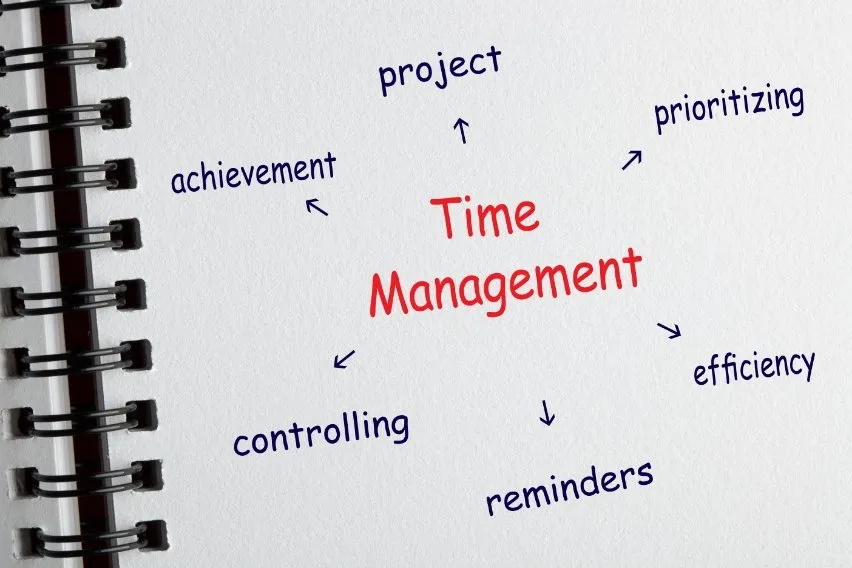Project Timeline: Benefits, Types & Best Practices

A project timeline can make or break the success of your endeavours. Learn how to create one that’s comprehensive.
You’ve probably heard the saying that a good plan is half the job done. This is absolutely true when it comes to project management. A timeline is a crucial part of the planning process. Without it, you can’t ensure your project stays on track and you’ll meet all the key deadlines.
Creating a detailed project timeline is no easy feat. Project managers usually have to put in quite some time and effort. But if you do it right, all that effort will pay off.
This guide will show you how to create a project timeline with all the elements necessary for your project to succeed.
Table of Contents
Benefits of a Project Timeline
How Do You Calculate a Project Timeline?
How to Create a Project Timeline
Best Practices in Making a Project Management Timeline
What Is a Project Timeline?
A project timeline is a detailed breakdown of tasks and activities in chronological order, as well as their duration. A project timeline helps you visualise a project and its key milestones. You can see exactly how everything should unfold from start to finish.
A timeline splits a project into more digestible units, such as project phases or tasks. This way, everyone can see their contribution and be on the same page.

Benefits of a Project Timeline
Timely delivery is crucial for a business’s reputation and integrity. Missing a deadline can damage your relationship with a client and even make them leave. That’s why you’ll want to do everything you can to ensure a project goes smoothly and you reach all the milestones without being late.
A project timeline helps you structure all activities and find the most efficient way to complete a project. By tracking everything, you can deal with eventual mishaps quickly and stay on track, ensuring optimal time management.
On top of this, a project timeline has many benefits.
- Better collaboration – A project timeline gives your team members a bird’s-eye view of the project. Team members can see the broader context of their activities and how they all come together. As a result, you’ll eliminate silos and let your entire team collaborate more efficiently.
- Efficient resource and time management – PMI’s research shows that a lack of resources was the main cause of project failure for 21% of businesses. By having a breakdown of all tasks involved in a project, you can use your resources more efficiently.
- Simplification – Looking at a large project can make it seem daunting. A project management timeline breaks a project down, making it seem less overwhelming and more easily doable. Everyone can focus on specific tasks instead of always thinking about the big picture.
Types of Project Timelines
There’s no one-size-fits-all solution for project timelines. Depending on your project type and specifics, you can choose between several formats.
- Gantt chart – By far the most popular project management timeline type is a Gantt chart. These are highly versatile and suitable for most project types. A Gantt chart shows lots of different information at once, giving you all the insight you need at a glance.
- Chronological chart – This is a simple project timeline type and is a good fit for projects with linear activities. It shows progress in a start-to-finish line, usually from left to right.
- Vertical or bar chart – This timeline type is commonly used in the financial sector. It features a horizontal axis representing time and a vertical axis showing the resources. It’s a good option for identifying long-term trends or managing resources.
How Do You Calculate a Project Timeline?
There are various methods for estimating a project’s duration so you can create an accurate timeline. Let’s discuss each in more detail.
Bottom-Up Estimating
Bottom-up calculation is the most accurate method for estimating a project’s timeline. The first thing you’ll want to do is break down a project into all its tasks. Then, you can allocate an appropriate amount of time to each individual task.
When you have specific task durations, add them up, and you’ll see how long it takes to complete the entire project.
There’s also the top-down approach. This approach is where you first estimate the overall time according to the end date, and then allocate its chunks to specific tasks. This isn’t a good standalone method, as it can be inaccurate and create a lot of uncertainty. It’s more commonly used to test the bottom-up estimation and confirm its accuracy.
Parametric Estimating
The parametric estimating method is suitable for projects with repetitive activities. You determine the time it takes to complete the activity and multiply it by the number of repetitions.
For instance, let’s say you want to publish 20 articles on your blog to boost your SEO. If it takes two days per article, the project duration will be 40 days.
Three-Point Estimating
It’s almost impossible to predict the exact duration of a project, especially larger ones. There are many moving parts to consider, so you’ll want to always leave some leeway.
That’s why a project manager may use three-point estimating. Instead of creating one timeline, they create three.
- Best scenario
- Worst scenario
- Most likely scenario
The goal is to ensure you can meet all the deadlines, even in the worst-case scenario. Doing so will eliminate frustration down the line.
How to Create a Project Timeline
Now that you understand the basics of project timelines, let’s see what it takes to create one. This is a multi-step process that involves meticulous planning, so you’ll want to give it the attention it deserves.
Here are the steps to creating a project timeline.
1. Define the Project Scope
Defining the project’s goals is a good starting point when creating a timeline. However, there are also many other factors to consider.
- Deliverables – What outputs do you need to create?
- Exclusions – What won’t be a part of the project?
- Constraints – What limitations are you facing?
- Tasks – What steps do you need to take?
Without defining the full scope of a project, you’ll very likely have an unreasonable estimate of its timeline, and you won’t have a clear path forward.
It’s best to have a project scope statement written down so other decision-makers can look at it. They can help you see if anything is missing before you’re ready to proceed with the timeline.
2. Outline All Relevant Tasks
There’s a high chance your project will involve more than one deliverable. That’s why you’ll need to split the tasks by deliverables and see what it takes to create each one.
Let’s say someone asked you to build them a chair. The first step of the process would be to design it. To do so, you’d need the following.
- A piece of paper
- A pen
- A ruler
If you don’t have any of these things, you’d have to go out and buy them. Once you do and complete the design, it’s time to build the chair, which requires supplies that need to be purchased.
- Wood
- Tools
- Nails
- Paint
- Glue
Each of these inputs will require time. For example, deciding what kind of nails you need and finding a hardware store that sells them. You’d then compare different options to your budget and find the most suitable one.
The point is, you must break down your project into as many tasks as possible to understand what goes into it and how long each step will take. Only then can you move onto the key stage.
3. Build Out the Schedule
With your tasks and their durations clearly outlined, it’s time to put it all together. Assuming you use the bottom-up approach, you’ll add up all these tasks to get the overall timeline.
Then, you’ll organise the tasks in chronological order, grouping them if needed. Many tasks will be concurrent, meaning they can happen simultaneously.
Always ensure there’s a logical sequence to your tasks to avoid going back and forth. It may take some time to put everything in proper order, so be patient and ensure you do it properly.
It’s best to use capable project timeline software to structure everything well. A comprehensive project management software should have it built. You can also find dedicated project timeline software if this isn’t the case.
You can also find many project management timelines that you can use as reference. Of course, you’ll have to adapt the project timeline template to your needs.
4. Set Deadlines and Assign Tasks
As useful as estimates are, they’re not reliable enough to ensure everything goes according to plan. Instead, setting hard end dates by which you want a task to be completed is a better idea. If you don’t set specific milestones, your project might steer off course pretty quickly.
Create deadlines based on your estimates, factoring in some room for error. Some things are beyond everyone’s control, so you must account for them in your timeline. A good project management tool will let you set deadlines without hassle and allow for such leeway.
With the schedule and milestones in place, you can start delegating tasks. Make sure everyone knows what you expect and how they can monitor progress. Give everyone insight into the whole timeline so they can see the part they’ll play.
Best Practices in Making a Project Management Timeline
By following the above steps, you can create a project plan timeline that clearly shows every step of your project. However, there are a few additional guidelines to keep in mind. Let’s go over the key ones.
1. Don’t Forget Task Dependencies
Some activities can’t happen without others that serve as their conditions. In the chair example, you can’t nail down the parts if you haven’t bought a hammer. We describe relationships between such tasks as task dependencies, which are crucial for your project.
To create a properly structured timeline, identify all dependencies and align them properly. A dependency can also be a resource, so highlight them in the timeline.
2. Be Flexible
While you’ll want to create a specific timeline, it doesn’t have to be set in stone. A project changes while going through different stages, so be ready to adapt accordingly.
Keep close track of the project progress to see if there’s a need to readjust anything. Perhaps a team member called in sick or you’ve run out of the materials you need. Such events can cause delays and waste your team’s time if you don’t deal with them swiftly, so ensure your whole team is agile.
3. Account for Handoffs
It’s not just your project tasks that take time; what happens between them does as well. If you’ll involve multiple teams in a project, transitions between them must be seamless and accounted for.
Handoffs can be a significant bottleneck if you don’t prepare your teams for them. Leave some leeway for complications during handoffs to stay on track if they happen.

Key Takeaways
Tight deadlines don’t have to be a source of stress if you plan your project properly. Choosing to use a comprehensive project timeline will save you many headaches. Create timelines to manage tasks effectively.
Even the slightest oversights can affect your timeline. Leave no stone unturned, and use capable project timeline software to have a clear task list and reach your project’s goals.
FAQs on Project Timeline
How do you identify project timelines?
Project timelines are detailed breakdowns of a project containing all its key tasks and timeframes.
Why is a project timeline important?
A project timeline is essential to ensuring you don’t miss deadlines and that all your activities go as planned.
What do you call a project timeline?
Since Gantt charts are such a commonly used method, a Gantt timeline can be synonymous with a project timeline.
RELATED ARTICLES

 Performance Standards: Levels, Types & Importance
Performance Standards: Levels, Types & Importance Top 15 Time Management Techniques That Work
Top 15 Time Management Techniques That Work How to Increase Productivity in the Workplace (10 Easy Tips)
How to Increase Productivity in the Workplace (10 Easy Tips) Quote vs Invoice: What’s the Difference?
Quote vs Invoice: What’s the Difference? Time Management Matrix: Definition, Importance & Benefits
Time Management Matrix: Definition, Importance & Benefits